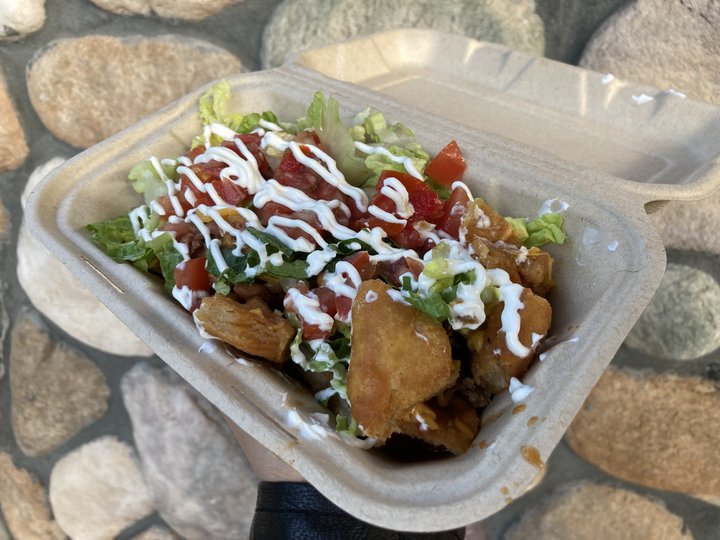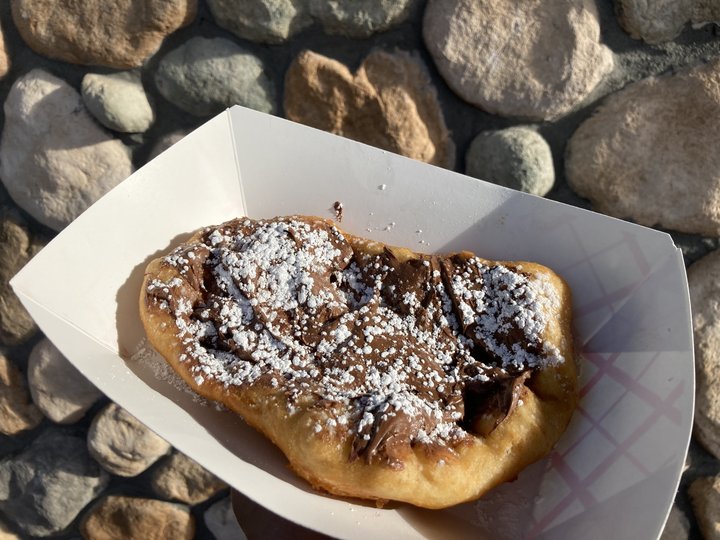
From left: Emma Sundberg, Aliesha Brown, Lisa Sundberg and Kayla Maulson at the Frybread Love stand. Photo by Jennifer Fumiko Cahill
###
Watching frybread go from a fist of pale dough pulled from a bucket to its final form, cumulus in shape and caramel in color, is like watching up-close magic. In a straw hat with a kitchen towel hanging from her shoulder, Lisa Sundberg pats, then pulls the dough with practiced hands, turning it to stretch under its own weight, pinching a few holes and laying it gently into the hot vegetable oil, where it bubbles and puffs, the oil shush-ing like distant applause.
Frybread itself is a feat of metamorphosis. In Native communities across the U.S., frybread is a staple and a comfort food born from displacement and the destruction of traditional resources and foodways that were replaced by government commodity foods, dating back to the Navajo people’s “Long Walk” from their homelands to New Mexico. “The government made us make frybread,” says Kayla Maulson, Sundberg’s daughter and owner of the Frybread Love stand newly opened outside Cher-Ae Heights Casino. “We were only given commodities … my dad said he grew up on commodities; they were given powdered milk, sugar, flour, salt.” From those rations came what Sundberg calls “a delicacy,” a base for a hearty chili taco, a jam-schmeared treat crispier and chewier than doughnuts, a satisfying comfort eaten plain and warm.

Lisa Sundberg shapes dough before frying, while her daughter Kayla Maulson ladles out chili for Indian tacos. Photo by Jennifer Fumiko Cahill
“It really is the shared experience across Indian country,” says Sundberg, who is Yurok.
Maulson, who studied childhood development and American Indian education, as well as business at Humboldt State University, was looking for something she could do while staying home with her two kids after the pandemic hit. Finally, the urgings of old rugby teammates and coworkers who’d been eating her family’s frybread for years got through and she started Frybread Love with help from her family, including her mother, her sister Aliesha Brown and cousin Emma Sundberg. By the time they packed up the tent the first night in front of the Cher-Ae Heights Casino, Maulson estimates they’d sold 200 orders. The next night it was triple that. Now, along with nights at the casino, she’s arranged a spot at the McKinleyville Farmers Market and is working on Arcata.
The ingredient list is short: flour, salt, sugar, baking powder and water. Maulson says her first try at frybread was making it for her father when her mother was out of town and she was 8 or 9. She’d mistakenly added cups of sugar rather than teaspoons. “But I was so happy he still ate it.” She’s got it down now but her mother remains the go-to frybread person in the family.
“I can finally accept that title,” says Sundberg. “I remember my first roll at fry bread … it was like the bottom of a shoe.”
Technique, Sundberg says, is everything. Working in the gaming industry helping design cash access systems, she traveled to Native-owned casinos all over the country, sampling frybread and asking questions. Mixing, emulsifying and kneading methods were a little different everywhere, with some regions using yeast or shaping the dough differently.
Sundberg and Maulson worked with Rhonda Wiedenbeck of Beck’s Bakery to source freshly stone-milled flour with higher amounts of gluten and protein. When allowed to rise for two hours, the result is a delicate chewiness, crisp exterior and fluffy center.

Frybread Love’s Indian taco. Photo by Jennifer Fumiko Cahill
The printed menu has an Indian taco with chili, cheese, lettuce and tomato, and a couple of sweet options, Nutella and powdered sugar. Both curious first-timers and those who grew up eating it order the plain bread. “It’s just a cherry on top having anything else with it,” says Maulson. She herself loves peanut butter and jelly. But the women are batting around all kinds of additions. Maulson, who’s also Ojibwe, notes that in the Midwest, frybread is sometimes served with wild rice and chicken soup. Her mother had served pork sliders with apple slaw on frybread and they’re hoping to work with local farmers on ingredients like blackberries and huckleberries.
According to Maulson and Sundberg, frybread isn’t something you make unless you’re serving 15 people. At Maulson’s grandmother’s family gatherings, 100 pieces, enough for dinner and dessert, would be standard. But a big gathering isn’t hard to come by for her family. “We have Grandma next door, we have Uncle down the hill, so we’re making it for at least 20 people. … You want to share it all, you’ve got a big huge pot of chili you’re making it with. You bring all your cousins or your aunties over. ‘Come over for a barbecue, we’re making frybread.’”

Hot frybread with Nutella. Photo by Jennifer Fumiko Cahill
Maulson and Sundberg’s family is among those who provide food for cultural events and ceremonies, too, like the annual Sumeg Brush Dance. There, community members share traditional foods like eel, acorn, salmon and frybread. They bring enough to feed the dancers, attendees and campers, sometimes up to 300 people. “I think that’s what everyone’s missed this past year,” says Maulson. “I really do miss the dances and staying up all night with the girls and hearing the songs.” They also cook for the recently revived girls’ Flower Dance coming-of-age ceremony, in which Maulson was among the first participants after its decades of dormancy.
Those ceremonies have been absent from local Native life since the COVID-19 pandemic put gatherings on hold. But the frybread is a taste of those days and dinners when people could come together to share traditions and meals that carry their shared history.
“We love frybread,” says Sundberg. “We love feeding people and we need that love to spread, to use frybread as a seed of love to reach out and hopefully bring us together again.”
###
Jennifer Fumiko Cahill (she/her) is the arts and features editor at the Journal. Reach her at 442-1400, extension 320, or jennifer@northcoastjournal.com. Follow her on Twitter @JFumikoCahill.
The Community Voices Coalition is a project funded by Humboldt Area Foundation and Wild Rivers Community Foundation to support local journalism. This story was produced by the North Coast Journal newsroom with full editorial independence and control
CLICK TO MANAGE